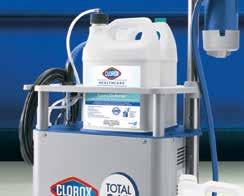
10 minute read
The Battleship on the Ground
from CHF Spring 2021
by MediaEdge
Lessons learned from advancements in naval technology shed light on current vulnerabilities in hospital design
By Chris McQuillan
Advertisement
In the 19th century, rapid technological advancement gave rise to the birth of the battleship. By the mid20th century, the Japanese Yamato-class ships stretched more than 850 feet, could hit speeds of 30 miles per hour and packed 18-inch artillery.
Like superhospitals, the battleship represents the ‘all in gambit.’ It had the largest guns, thickest armor, best technology and was staffed by the most senior commanders. The battleship was a flagship, both literally and metaphorically.
From the first, the HMS Dreadnought, to the last, the enormously powerful Yamato, the history of the battleship spans a brief period from 1906 to 1945. The HMS Dreadnought’s claim to fame was that it was the only battleship to ever sink an enemy submarine. The ship was sold for scrap 15 years after its maiden voyage. The mighty Yamato helped take down two small vessels before being destroyed by American bombers during World War 2.
What's most interesting is not what happened to these ships but why they were built in the first place. What appeared revolutionary at the time is now understood to be, at best, folly. Both were obsolete long before they put to sea.
The battleship represented the pinnacle of military technology. It was considered invincible until it wasn’t. COVID-19, and the communicable diseases that preceded and will follow it, present similar challenges to the healthcare sector.
EVIDENCE OF VULNERABILITY
Like the unforeseen enemies of the battleship, superhospitals are similarly under attack by unpredictable forces — unknown viruses, climate change, natural and human-caused disasters, and exponential technological change. In August 2020, the devastating explosion in the port of Beirut put three of the Lebanese capital’s hospitals out of action. When superstorm Sandy hit New York City in 2012, several of the city’s major medical institutions had to be evacuated after multiple electrical and mechanical systems failed. Now, many hospitals are overwhelmed by COVID-19 patients amid the second wave of the pandemic.
Today, hospitals are bigger than ever, packed with so many ancillary components
that food courts and shopping areas need to be included. Billions of dollars of physical and, more importantly, human capital are focused in a large and vulnerable target. There is no better proof of the frailty of hospitals than the suspension of their services and the rapid construction of field hospitals in their parking lots.
Battleships needed many months and years in dry dock for refits and repairs, during which all the functionality was unavailable. Large hospitals are similarly difficult and expensive to adapt. Operational experience has shown how hard it is to stream care, and assess and separate patient populations. Many of the most advanced medical systems in the world have been paralyzed. The U.S. spends close to double (per capita) on healthcare and has been one of the hardest hit nations. The emphasis on large, singular hospitals puts the healthcare system at the mercy of attack from the very people they seek to help.
ADAPT TO SURVIVE
COVID-19 has been a lesson in universal unpredictability. Advances in technology, medical equipment, treatments and even patient expectations make rendering confident predictions about healthcare irresponsible. Instead, designing spaces with a high level of adaptability will allow physical structures to flex and respond accordingly as situations dictate.
The navy’s response to the battleship’s unsuitability for the task at hand was to completely reevaluate its strategy. Navies adopted aircraft and autonomous tools like missiles and drones that in combination with stealth replaced the overt force concentrated in large vessels. Most ships have become smaller, quicker and more focused in their functional roles. With less invested in each component of the strategy, it has created greater adaptability and the opportunity to rethink inter-functionality on a fluid and ongoing basis as new challenges arise. Battle is no longer a ship-to-ship broadside but is carried out from great distances with detailed analysis and executed with tremendous precision.
Renderings courtesy B+H Architects

t OPPOSITE PAGE: Patients experience a unique micro-landscape within and around the new Shenzhen Children’s Hospital in China. ABOVE: Patients are connected back to nature in the ‘urban living room.’
TOMORROW IS ALREADY HERE
The healthcare industry is ready for a similar transformation. The need for flexibility in built structures must extend far beyond hospitals to include the reassessment of healthcare infrastructure.
There is evidence the current health crisis has driven a rapid adoption of many technologies and more progressive outlooks on how to approach ‘health’ in society. Now, more than ever before, expertise is mobile. Diagnostics can be performed anywhere. Outpatient procedures are the majority of those performed. The system already relies on data collected remotely and shared electronically. Collaboration is mainly virtual. What’s more, COVID-19 has accelerated patients’ comfort with virtual health visits. Many tests can now be performed at home, a pharmacy or in other places outside brick-and-mortar hospitals.
The acceleration of nascent technologies and widespread innovation has been seen globally. Israel’s Leumit Health Care Services designed and deployed a mobile testing unit in partnership with the country’s army. China’s Ping An Good Doctor booths employ a combination of artificial intelligence (AI) and real-time links to healthcare professionals coupled with onboard diagnostics that serve more than three million users. A built-in pharmacy vending machine fulfills 100-plus common medications. Robotic surgery techniques mean a surgeon can be working in the next room — or half the world away. Care that was only recently available in a hospital lab and nephrology department is now a sticker on the patient’s arm communicating with an app. Medical diagnostic and treatment equipment that used to need its own room is now pocket-sized. Studies using AI to perform radiology and pathology diagnoses are outperforming human experts, and people are now collecting vast data sets of their own longitudinal health, revolutionizing preventive care.
Ultimately, the 21st century ‘battleships’ are superhospitals. However, it is crucial to understand the crisis wasn’t in hospitals; it was in the infrastructure outside these facilities. COVID-19 has forced society to re-evaluate the purpose of its buildings — from homes and workplaces to airports, hotels and public spaces — and the quality of human activity expected from them. The question is not how design will shift to suit the pandemic but how the pandemic will alter design thinking and elicit greater introspection on how and why to design for the future.
The truth about Healthcare-associated infections.
Healthcare-associated infections (HAIs) are infections that patients get while receiving treatment for medical or surgical conditions. Many HAIs are preventable.1
In the news. Some infectious diseases that start in the community such as severe acute respiratory syndrome (SARS), Middle East Respiratory Syndrome (MERS) and COVID-19, the cause of the current pandemic, may also spread in healthcare facilities.2 Where do they happen?
HAIs occur in all types of care settings, including acute care hospitals, ambulatory surgical centres, dialysis facilities, outpatient care facilities (e.g., physicians’ offices and healthcare clinics), and long-term care facilities (e.g., nursing homes and rehabilitation facilities).1 According to the Canadian Nosocomial Infection Surveillance Program (CNISP), one in 217 patients acquired an infection while in hospital in 2017. While some HAIs were reduced over time, such as Clostridium difficile infections which were reduced by 25% from 2013 to 2017, other HAIs such as vancomycin-resistant enterococci (VRE) infections increased by 25%.3 Device-associated infections, such as ventilator-associated pneumonia, catheter-associated urinary tract infections (CAUTIs), surgical site infections (SSIs) associated with a prosthetic implant and central line–associated bloodstream infection (CLABSIs), accounted for 35.6% of all health care-associated infections in 2017.4
Common types of HAIs.
Common types of HAIs include:2 • Central line-associated bloodstream infections (CLABSI) • Catheter-associated urinary tract infections (CAUTI) • Surgical site infections (SSI) • Clostridium difficile infections • Methicillin-resistant staphylococcus aureus (MRSA) infections • Vancomycin-resistant enterococci (VRE) infections • Carbapenem-resistant Gram-negative bacterial infections
The burden of HAIs.
HAIs constitute a significant burden to society, as they cause significant morbidity and mortality in hospitalized patients. More than 200,000 patients are infected every year while receiving healthcare in Canada and estimates suggest that HAIs are linked to between 8,500 and 12,000 deaths per year, making these infections the fourth leading cause of death for Canadians (behind cancer, heart disease, and stroke).5 Treatment costs for HAIs are high as the cost of containment and control of these outbreaks can really add up.6 Additionally, after discharge, patients with HAIs have significantly higher personal medical costs than uninfected patients. They require more visits from community nurses, greater reliance on hospital outpatient and emergency services, and more visits to their family doctor.2
Prevention is critical.
Environmental cleaning and disinfection is a critical strategy for HAI prevention. According to the Provincial Infectious Disease Advisory Committee (PIDAC), environmental cleaning in the healthcare setting must be performed on a routine and consistent basis to provide for a safe and sanitary environment.7 Cleaning and disinfecting products must be approved by environmental services, infection prevention and control and occupational health and safety.7 Disinfectants must have Health Canada approval and should be compatible with surfaces, finishes, furnishings, items and equipment to be cleaned and disinfected.7 Additionally, they must be used according to the manufacturer’s recommendations and be effective against the microorganisms encountered in the healthcare setting.7
Researchers estimated that about 70% of some types of HAIs could reasonably be prevented if infection prevention and control strategies are followed.8
Make CloroxPro™ part of the process.
CloroxPro™ offers multiple Health Canada–registered disinfectants based on three categories of active disinfectant ingredients – quaternary ammonium compounds (or “quats”), chlorine releasing compounds (such as bleach), and peroxygen compounds (such as hydrogen peroxide), to help meet your healthcare facility’s unique needs.
Learn more, or request a product demo at CloroxPro.ca | healthcare@clorox.com
References: 1. Healthcare-associated infections. Healthy People 2020. https://www.healthypeople.gov/2020/topics-objectives/topic/healthcare-associated-infections Accessed March 10, 2020. 2. Evaluation of healthcareassociated infection activities at the Public Health Agency of Canada 2012-13 to 2016-17. March 2018. https://www.canada.ca/content/dam/phac-aspc/documents/corporate/transparency/corporate-management-reporting/ evaluation/HAI_evaluation-eng.pdf Accessed March 12, 2020. 3. Healthcare-associated infection rates in Canadian hospitals. Public Health Agency of Canada. Canadian Nosocomial Infection Surveillance Program (CNISP). https://www.canada.ca/content/dam/canada/public-health/services/publications/science-research-data/healthcare-associated-infection-rates-canadian-hospitals-infographic/CNISP-2013-2017-infographic-eng.pdf Accessed March 13, 2020. 4. Mitchell R, et al. Trends in healthcare-associated infections in acute care hospitals in Canada: An analysis of repeated point-prevalence surveys. CMAJ 2019;191(36):E981-8. 5. Health care associated infections: A backgrounder. Canadian Union of Public Employees, 2009. https://cupe.ca/sites/cupe/files/healthcare-associated-infections-cupe-backgrounder.pdf Accessed March 9, 2020. 6. Dik J-W H, et al. Cost-analysis of seven nosocomial outbreaks in an academic hospital. PLoS ONE 2016;11(2):e0149226. 7. Ontario Agency for Health Protection and Promotion (Public Health Ontario), Provincial Infectious Diseases Advisory Committee. Best practices for environmental cleaning for prevention and control of infections in all health care settings. 3rd ed. Toronto, ON: Queen’s Printer for Ontario; 2018. 8. The Chief Public Health Officer’s Report on the state of public health in Canada 2013: Infectious Disease – The Never-ending Threat. https://www.canada.ca/content/dam/phac-aspc/migration/phac-aspc/cphorsphc-respcacsp/2013/assets/pdf/2013-eng.pdf Accessed March 16, 2020.

The invisible guardian.


Everyday sporicidal protection now available for the Clorox Total 360® system. for the Clorox Total 360® system.





In addition to our current line of disinfection formulations and products, CloroxPro™ offers a new Spore Defense™ formulation, exclusively for the Clorox Total 360® system. This powerful new chemistry is Health Canada-approved to kill: ♦ C. difficile in 5 minutes ♦ 42 out of 47 pathogens in just 1 minute, including MRSA, VRE, measles & polio Clorox Total 360® system with Spore Defense™, when used regularly, provides Clorox Total 360® system with Spore Defense™, when used regularly, provides your facility with invisible yet effective outbreak prevention.



